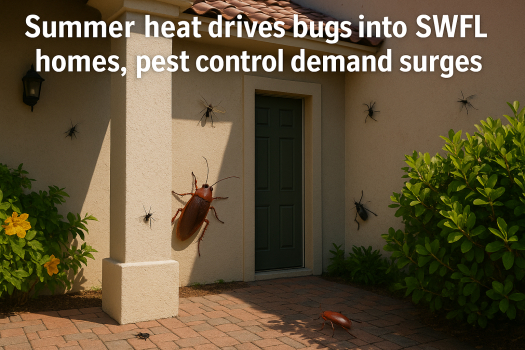Summer heat drives bugs into SWFL homes, pest control demand surges
Summer heat drives pests indoors, increasing infestations. Learn how to protect your home and when to call professional pest control experts.

As temperatures soar during the summer months, homeowners across the United States are experiencing a significant uptick in unwanted insect visitors. Pest control companies are reporting a surge in service calls as bugs seek refuge from the heat by invading homes.
Why Are Pests Invading Homes?
Insects are cold-blooded creatures, meaning their body temperature and activity levels are influenced by the environment. As the mercury rises, their metabolism accelerates, leading to increased feeding and reproduction rates. Coupled with the search for cooler, more hospitable environments, this drives many pests indoors.
Additionally, changes in rainfall patterns, such as droughts or heavy storms, can disrupt natural habitats, pushing pests to seek shelter and sustenance in human dwellings. The combination of heat and altered moisture levels creates ideal conditions for pests to thrive inside homes.
Common Summer Pests
Several pests become particularly problematic during the summer:
-
Ants: Attracted to food and water sources, ants often infiltrate kitchens and pantries. Species like ghost ants and fire ants are prevalent in warmer regions.
-
Cockroaches: These resilient insects seek out moist, dark environments. Once inside, they can rapidly multiply and are known to spread bacteria. Mosquitoes: Standing water from summer rains provides breeding grounds for mosquitoes, which can transmit diseases like West Nile virus and Zika virus.
-
Termites: Warm, humid conditions accelerate termite activity, increasing the risk of structural damage to homes.
-
Spiders and Earwigs: These pests often enter homes in search of cooler environments and prey, becoming more noticeable during the summer.
Preventative Measures
To safeguard your home against summer pests, consider the following strategies:
-
Seal Entry Points: Inspect your home's exterior for cracks, gaps, and holes, especially around windows, doors, and utility penetrations. Use caulk or weather stripping to seal these openings. Maintain Cleanliness: Regularly clean kitchens and dining areas to eliminate food crumbs and spills. Store food in airtight containers and promptly dispose of garbage.
-
Manage Moisture: Fix leaky faucets and pipes to reduce moisture that attracts pests. Ensure gutters and downspouts are clear to prevent water accumulation.
-
Yard Maintenance: Keep grass trimmed and remove yard debris, such as leaves and branches, which can serve as nesting sites. Trim bushes and trees away from the house to eliminate bridges for pests.
-
Proper Lighting: Use yellow or sodium vapor light bulbs for outdoor lighting, as they are less attractive to insects compared to standard white lights.
-
Regular Inspections: Schedule routine inspections with pest control professionals to identify and address potential infestations early.
Professional Pest Control Service
While DIY methods can be effective for minor issues, professional pest control services offer comprehensive solutions:
-
Customized Treatment Plans: Professionals assess your specific situation and develop targeted strategies to eliminate pests.
-
Safe and Effective Products: Licensed exterminators use EPA-approved products that are safe for humans and pets while effectively controlling pests.
-
Ongoing Monitoring: Regular follow-ups ensure that pest populations remain under control and help prevent future infestations.
Conclusion
The summer heat not only affects humans but also drives pests indoors in search of cooler environments. By understanding the reasons behind this seasonal surge and implementing preventative measures, homeowners can protect their living spaces. For persistent or severe infestations, enlisting the help of professional pest control services ensures a safe and comfortable home environment throughout the summer months.













